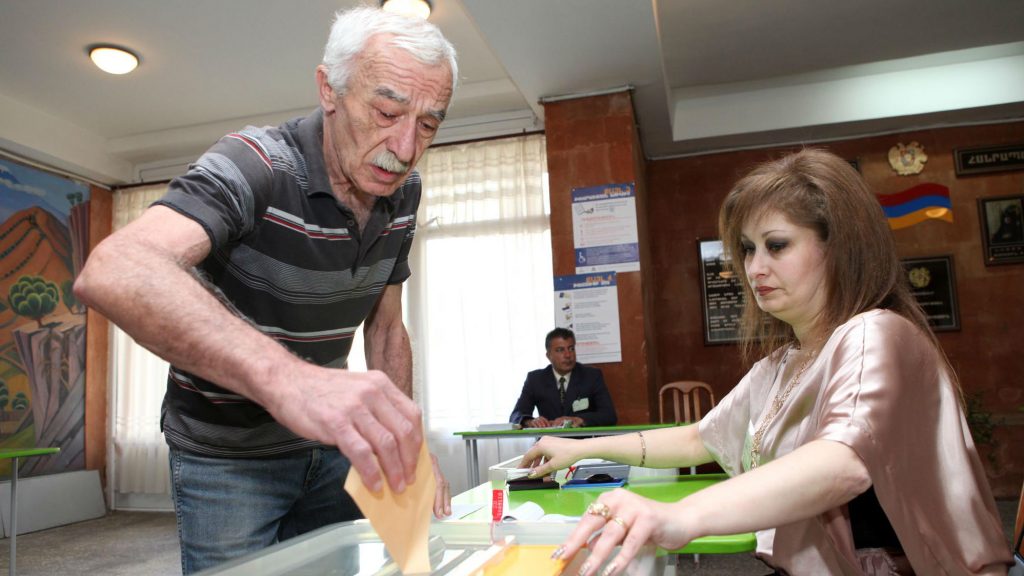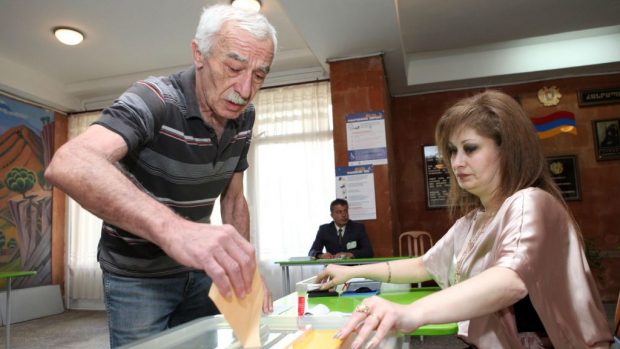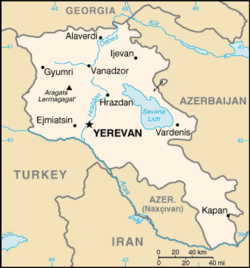
Armenian Elections and Regional Implications
 On April 2, Armenians will go to the polls to elect a new parliament. Although Armenia has a very poor record of free and fair elections, this particular ballot stands as a milestone for the country; this for several reasons.
On April 2, Armenians will go to the polls to elect a new parliament. Although Armenia has a very poor record of free and fair elections, this particular ballot stands as a milestone for the country; this for several reasons.
First, this election marks the start of the transformation to a full parliamentary form of government, as part of a process that will culminate in the phasing out of the current semi-presidential system by 2018. It also features new factors, ranging from a political transition involving the emergence of a new political opposition and to the promotion of a new younger political elite. Both the newly established opposition and the rising political elite are defined not only by a starkly different political style and approach than their predecessors, but each stands out as representatives of a new, younger generation of leaders and candidates.
The coming election is also significant as a crucial test of democracy. And given that a series of past elections were tainted by voting irregularities and fraud, there is a real risk of unrest if this election is yet another missed opportunity for a clean election.
That risk of post-election unrest is also magnified by the fact that Armenian society has changed, with a demonstrable end to apathy and a pronounced rise in civic activism. In addition, the government seriously and dangerously underestimates the level of deep-seated discontent, a trend that is only exacerbated by serious economic crisis driven by a sharp fall in remittances, or money coming into the country from Armenians working abroad.
Against that backdrop of entrenched corruption and widening disparities of wealth and income, the undercurrent of instability and simmering discontent may also drive a potent challenge to the election outcome. This also means that it is ever more risky for any incumbent Armenian government to continue to ignore popular demands and pressing expectations for change in the country.
And given Armenia’s track record, there is little to inspire confidence in the election. Yet, this election may be an improvement in terms of election observation, mainly due to the deployment of effective technological tools. Any such improvement in a demonstrably “more free” election may be offset by a contest that will be significantly “less fair.” Such a scenario stems from the abuse of the advantages of incumbency, or so-called “administrative resources,” in which the ruling government leverages the extensive perks of political patronage of office by pressuring civil servants and state workers to vote for the ruling party.
Broader Implications
Although the campaign for the Armenian parliamentary election is marked more for a poverty of ideas, with a political campaign dominated more by a contest of personalities than a competition of policies, the political narrative of the election does have broader regional implications.
 Since independence, there have been two notable central elements of Armenian domestic politics that remain unchanged and unchallenged. And both of these two core issues have defined and constrained Armenian foreign policy, as well limiting domestic discourse and debate. The first of these core issues has been Armenia’s relationship with neighboring Turkey. Despite the suspension of diplomatic efforts to “normalize” relations, Armenia’s policy towards Turkey has become more nuanced, moving past the limits of prioritizing the Armenian genocide above all else.
Since independence, there have been two notable central elements of Armenian domestic politics that remain unchanged and unchallenged. And both of these two core issues have defined and constrained Armenian foreign policy, as well limiting domestic discourse and debate. The first of these core issues has been Armenia’s relationship with neighboring Turkey. Despite the suspension of diplomatic efforts to “normalize” relations, Armenia’s policy towards Turkey has become more nuanced, moving past the limits of prioritizing the Armenian genocide above all else.
But it is the Nagorno-Karabakh conflict that, as the second essential factor of Armenian foreign policy, presents a much more dynamic and more direct challenge. The inherent challenge of managing a stalled peace process, coupled with the ever present threat of ceasefire violations and border skirmishes, have only exacerbated the closed nature of internal politics, which has been marked by an environment that has only forced out more moderate views in favor of a more militant stand within the domestic political spectrum.
And in the wake of the most serious escalation of fighting since the mid-1990s that was triggered by a large-scale Azerbaijani military offensive, it became obvious that the “frozen” conflict over Nagorno-Karabakh had entered a new, much more serious combat phase, but also poses new risks to the regional security and stability.
From a larger perspective, the dominance of the Karabakh conflict as the main political issue is both a driver and an outcome of a deepening crisis in Armenian-Russian relations. For many Armenians, this crisis is a culmination of frustration with the asymmetry and disrespect with which Russia treats its Armenian “ally,” exacerbated by the sense of betrayal by Russia, which has emerged as the primary arms provider to Armenia’s rival Azerbaijan.
The Outlook
Looking ahead, in the run up to the country’s parliamentary election, Armenia’s ruling Republican Party has already moved to shape the political discourse by stressing national security, aimed to both repair its own damaged image in the wake of losing territory in the April 2016 fighting with Azerbaijan, and to restore its political posture as a strong and decisive party capable of leadership and statesmanship. Yet, with an increasingly likely risk of renewed hostilities over Nagorno-Karabakh in the coming months, the domestic political landscape in both Armenia and Azerbaijan will only continue to be dominated by an agenda driven by security and defense issues. And sadly, this will only elevate the nationalist rhetoric and once again spark a “race to the bottom” for the region.


